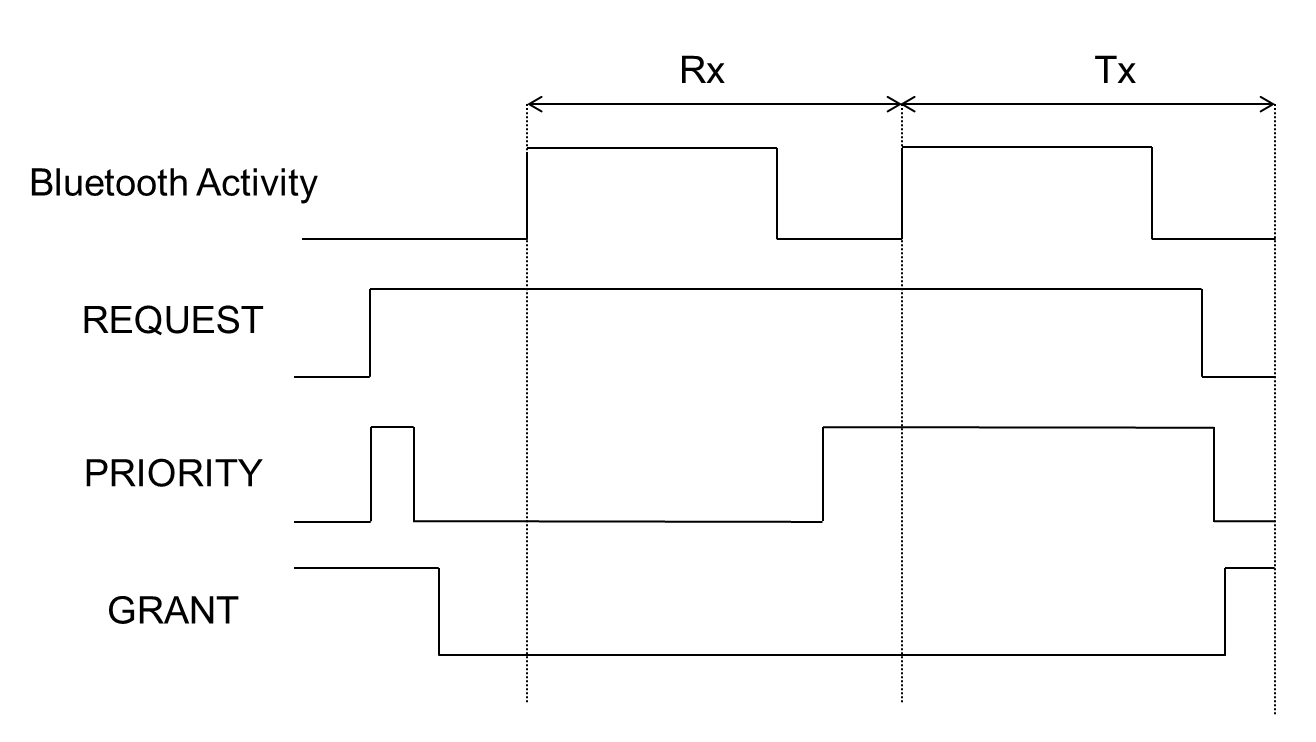SWRA654A December 2019 – April 2020 CC2652R , CC2652R7 , CC2652RSIP
3.4.2 Bluetooth
The Bluetooth implementation of coexistence can either be three- or one-wire. The feature works for both separate or shared antennas. The three-wire coexistence consists of; REQUEST, PRIORITY, and GRANT signals, and the one-wire coexistence consist of either the REQUEST or GRANT signal. Figure 7 displays the three-wire coexistence between a SimpleLink CC13x2/CC26x2 device and the Wi-Fi chip.
 Figure 7. Block Diagram of Three-Wire Coexistence
Figure 7. Block Diagram of Three-Wire Coexistence REQUEST is sent from the Bluetooth device to the Wi-Fi device to request permission to use the antenna. The Wi-Fi device responds with the GRANT signal to either grant or deny the request. PRIORITY is a time-shared output signal from the Bluetooth device indicating both priority and the type of RF activity. REQUEST and PRIORITY are active high, and GRANT is active low. Figure 8 shows an illustration of the typical behavior when the Bluetooth device wants to transmit or receive data. The illustration only shows an example of the signals, not physical measurements.
 Figure 8. Timing Diagram of the Three-Wire Coexistence Signals
Figure 8. Timing Diagram of the Three-Wire Coexistence Signals Figure 9 illustrates a block diagram of one-wire REQUEST coexistence. The one-wire REQUEST coexistence only uses the REQUEST signal to notify the Wi-Fi device that Bluetooth activity is pending. This means that the Bluetooth device does not wait for the Wi-Fi device to indicate whether the right to transmit has been granted to the Bluetooth device. This option may lead to losing data packets since both protocols may send or receive data at the same time. Bluetooth assumes it always has the highest priority because Wi-Fi is less sensitive to time-domain disturbances. The SimpleLink Wi-Fi devices that currently support coexistence are CC3135, see CC3135 Product Page, or any of the CC3235 devices.
 Figure 9. Block Diagram of One-Wire REQUEST Coexistence
Figure 9. Block Diagram of One-Wire REQUEST Coexistence Figure 10 illustrates a block diagram of one-wire GRANT coexistence. The one-wire GRANT coexistence only uses the GRANT signal. This means that when the Wi-Fi device asserts GRANT, the Bluetooth device is allowed to transmit or receive packets. When the GRANT signal is de-asserted, the Bluetooth device has to stop sending or receiving data. Since the Bluetooth device cannot request the use of the antenna, there is a risk of missing essential packets or creating a large queue of outgoing packets from the Bluetooth device.
 Figure 10. Block Diagram of One-Wire GRANT Coexistence
Figure 10. Block Diagram of One-Wire GRANT Coexistence More information about Bluetooth coexistence is found in the coexistence chapter of the User's Guide and the SimpleLink Academy coexistence lab.